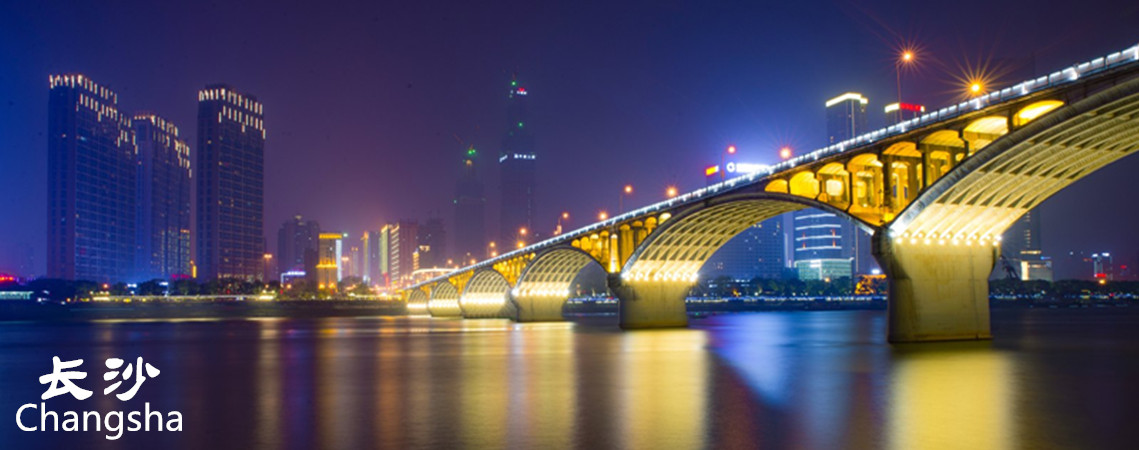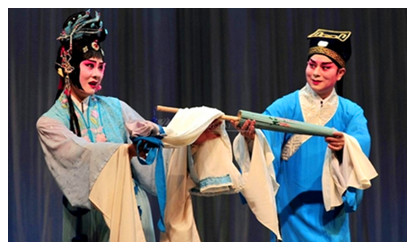
Xiang Opera of Changsha
 Xiang Opera, a major, local opera, was formed during the Ming Dynasty (1368-1644). The opera was mostly performed in the provincial capital Changsha, and in nearby Xiangtan, hence the name Changsha Xiang Opera. It has 12 types of roles such as Sheng (male role), Dan (female role), Chou (clown or comic role), and 'flower-faced' roles (a popular name for jing or male roles, because of the elaborate facial painting used). Non-martial scenes are accompanied by instruments like flutes and yu-kin, an ancient stringed instrument, while percussive instruments accompany martial scenes.
Xiang Opera, a major, local opera, was formed during the Ming Dynasty (1368-1644). The opera was mostly performed in the provincial capital Changsha, and in nearby Xiangtan, hence the name Changsha Xiang Opera. It has 12 types of roles such as Sheng (male role), Dan (female role), Chou (clown or comic role), and 'flower-faced' roles (a popular name for jing or male roles, because of the elaborate facial painting used). Non-martial scenes are accompanied by instruments like flutes and yu-kin, an ancient stringed instrument, while percussive instruments accompany martial scenes. Xiang Opera of Changsha is a major local opera in Hunan province. It was formed in the Ming Dynasty when Jiangxi Yiyang Qiang was introduced and incorporated into the local dialect and folk music in regions including Changsha.
The so-called “Xiyang shadow still floats on water though it falls, and Nanqu tone is low and changes repeatedly” was a depiction of the Yiyang Qiang (a branch of southern opera). Xiang Opera used to be called “people play” or “great play”. It consisted of the four genres of tunes including Gaoqiang, Dipaizi, Kunqiang and Tanqiang. Some of them are rough and bold in style while others are tactful and smooth with strong local characteristics.
Since it was performed in the Changsha dialect and performed in areas centered around Changsha and popular in the 12 states and counties under the former Changsha Prefecture, it was called Changsha Xiang Opera. In early years, the Laolang Temple in Changsha kept the Fuxiu Class Card for the year of 1664 (the third year during the Qing Dynasty Emperor Kangxi’s reign). The Jiulin Class organized in the late Qianlong period (1736-1795) was the earliest opera class ever founded in Hunan.
Later on, hundreds of opera classes were started, but the Wuyun Class and the Tongchun Class were the most influential ones. These classes featured different genres and schools. For example, the Fuxiu Class focused on Gaoqiang, while the Dapuqing Class focused on Kunqiang, and the Renhe Class mainly concentrated on Tanchangqiang. Based on the characters, the performance of Xiang Opera has 12 types of roles, namely, the Da Kao (the main male role), Er Kao (old man supporting role), Chang Gong (main female role), Xiao Sheng (young male role), Da Hua Lian (big painted face), Er Hua Lian (small painted face), San Hua Lian (clown), Zi Lian (decorated face for duet), Zheng Dan (noble female role), Zuo Gong Dan (vivacious young females), Qiao Dan (including small female role and acrobatic fighting role) and Po Dan (elderly women role) etc.
There are more than 680 traditional Xiang Opera tunes, in which over 500 are Luan Tan and more than 100 are Gao Qiang. “Si Da Lian Tai” and “Liu Da Ji” are the typical Gaoqiang tunes that have been performed and kept going for a long time. Many of them originated from the southern opera in the late Song Dynasty, the Yuan Dynasty opera, and the Ming and Qing Dynasties’ legends. Most of them were based on historical romance, popular stories or folk legends.
“Si Da Lian Tai” refers to The Investiture of the Gods, Legend of Mulian, Journey to the West and A Biography of the Patriotic General Yue Fei, each of which can be performed for 5-7 days with a coherent and full story. “Liu Da Ji (Six Major Stories)” refers to The Story of Golden Stamp, The Story of the White Rabbit, The Story of Giving up Civilian Pursuit, The Story of Pipa, Paying Tribute to the Moon, and The Story of Bramble Hairpin. In addition, there are other Luan Tans such as “Ba Da Lian Tai”, “Jiang Hu Shi Ba Ben” and “36 An Yuan.
Despite all this, today there are only two theatres left - Hunan Xiang Opera Theatre and Changsha Xiang Opera Theatre. Geographically, the opera is now only seen in Changsha.
The so-called “Xiyang shadow still floats on water though it falls, and Nanqu tone is low and changes repeatedly” was a depiction of the Yiyang Qiang (a branch of southern opera). Xiang Opera used to be called “people play” or “great play”. It consisted of the four genres of tunes including Gaoqiang, Dipaizi, Kunqiang and Tanqiang. Some of them are rough and bold in style while others are tactful and smooth with strong local characteristics.
Since it was performed in the Changsha dialect and performed in areas centered around Changsha and popular in the 12 states and counties under the former Changsha Prefecture, it was called Changsha Xiang Opera. In early years, the Laolang Temple in Changsha kept the Fuxiu Class Card for the year of 1664 (the third year during the Qing Dynasty Emperor Kangxi’s reign). The Jiulin Class organized in the late Qianlong period (1736-1795) was the earliest opera class ever founded in Hunan.
Later on, hundreds of opera classes were started, but the Wuyun Class and the Tongchun Class were the most influential ones. These classes featured different genres and schools. For example, the Fuxiu Class focused on Gaoqiang, while the Dapuqing Class focused on Kunqiang, and the Renhe Class mainly concentrated on Tanchangqiang. Based on the characters, the performance of Xiang Opera has 12 types of roles, namely, the Da Kao (the main male role), Er Kao (old man supporting role), Chang Gong (main female role), Xiao Sheng (young male role), Da Hua Lian (big painted face), Er Hua Lian (small painted face), San Hua Lian (clown), Zi Lian (decorated face for duet), Zheng Dan (noble female role), Zuo Gong Dan (vivacious young females), Qiao Dan (including small female role and acrobatic fighting role) and Po Dan (elderly women role) etc.
There are more than 680 traditional Xiang Opera tunes, in which over 500 are Luan Tan and more than 100 are Gao Qiang. “Si Da Lian Tai” and “Liu Da Ji” are the typical Gaoqiang tunes that have been performed and kept going for a long time. Many of them originated from the southern opera in the late Song Dynasty, the Yuan Dynasty opera, and the Ming and Qing Dynasties’ legends. Most of them were based on historical romance, popular stories or folk legends.
“Si Da Lian Tai” refers to The Investiture of the Gods, Legend of Mulian, Journey to the West and A Biography of the Patriotic General Yue Fei, each of which can be performed for 5-7 days with a coherent and full story. “Liu Da Ji (Six Major Stories)” refers to The Story of Golden Stamp, The Story of the White Rabbit, The Story of Giving up Civilian Pursuit, The Story of Pipa, Paying Tribute to the Moon, and The Story of Bramble Hairpin. In addition, there are other Luan Tans such as “Ba Da Lian Tai”, “Jiang Hu Shi Ba Ben” and “36 An Yuan.
Despite all this, today there are only two theatres left - Hunan Xiang Opera Theatre and Changsha Xiang Opera Theatre. Geographically, the opera is now only seen in Changsha.







 Ask Questions ?
Ask Questions ?